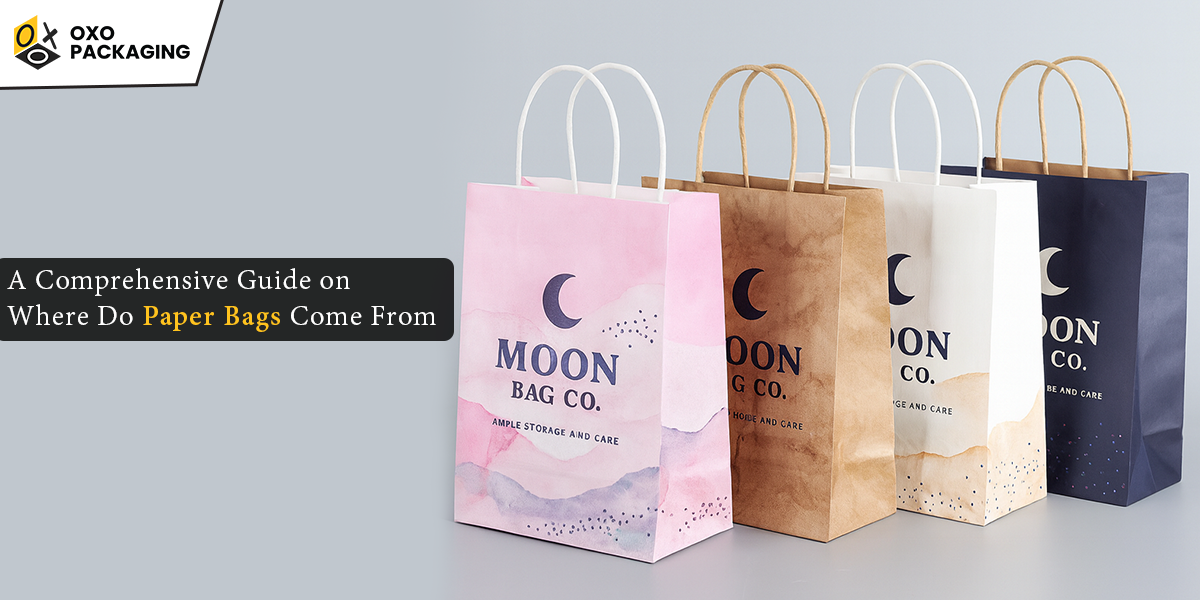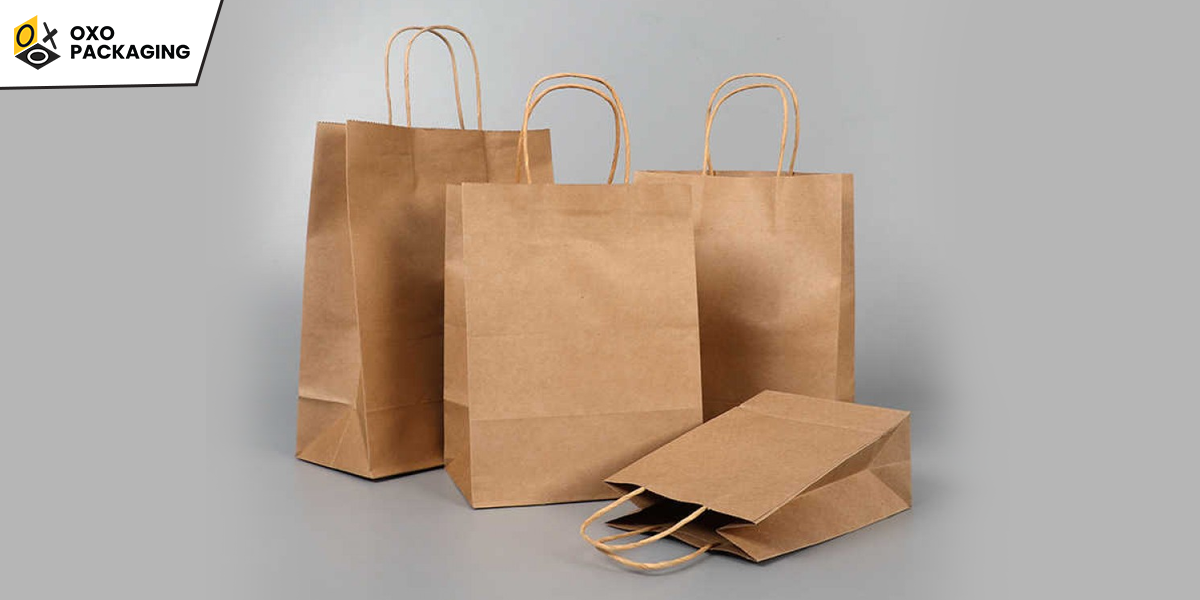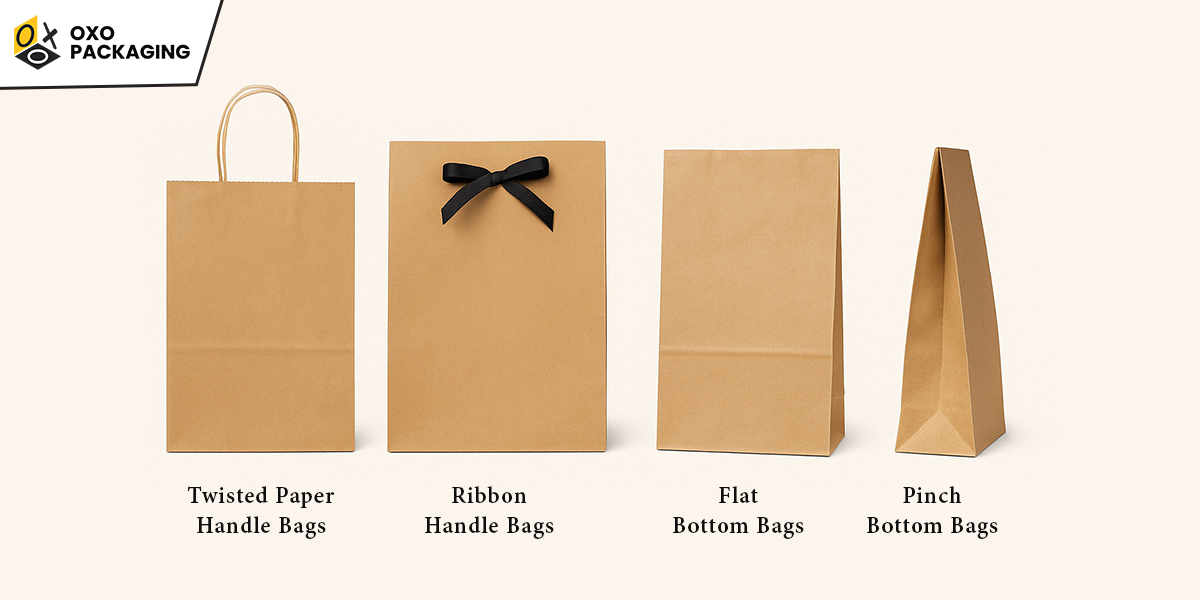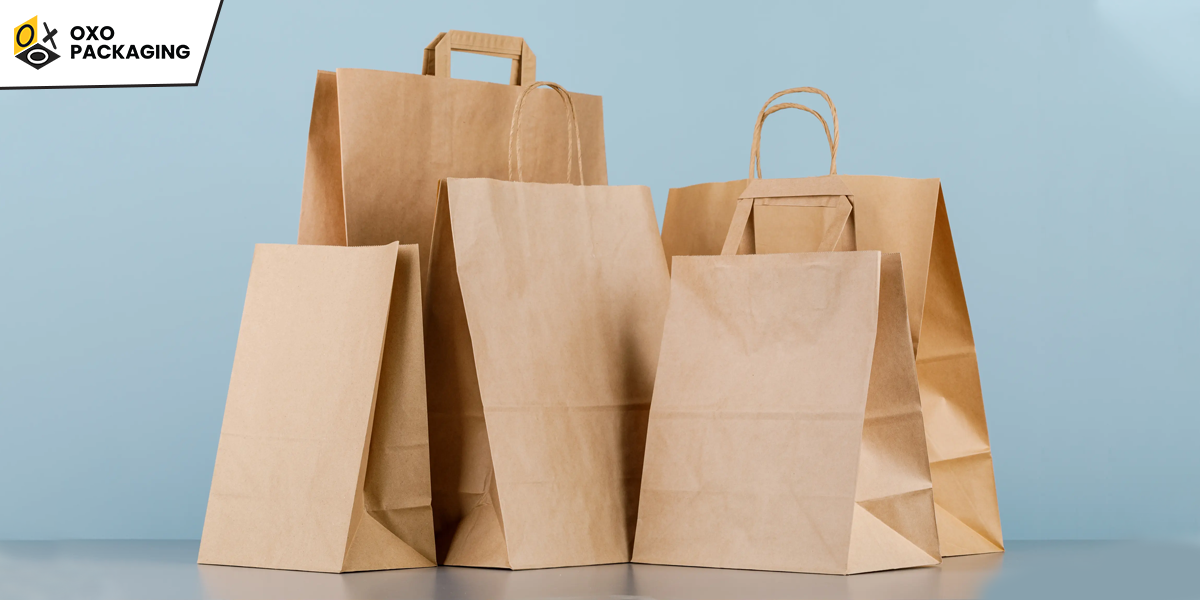A Comprehensive Guide on Where Do Paper Bags Come From?

Sustainable packaging has become a crucial aspect of packaging. And paper bags stand out as a staple in environmentally friendly packaging solutions. They offer a sustainable alternative to plastic bags. But where do paper bags come from? To get an answer to this query, read this blog in detail to know everything about paper bags.
Where Do Brown Paper Bags Come From?

If you think paper bags belong to modern era products, you are highly mistaken. Because paper bag origination dates back to the 18th century. Although paper bags were in basic shape, to something closer to what we would recognize today.
However, the 20th century witnessed modern packaging designs for paper bags. These designs exemplified the inside-packed products and became silent ambassadors of small to large-scale brands and businesses.
How Paper Bags are Made?
There are several steps involved in paper bag manufacturing. Here is a step-by-step overview of how paper bags are made:
-
Paper Bag Material
The quality of a paper bag depends upon its manufacturing materials. Raw materials like wood pulp or recycled paper determine the resilience of the paper bag. Hence, choosing materials determines functional attributes like strength and load-bearing capacity of the bag.
For example, B2B customers may choose kraft paper due to its sturdiness and easy recycling process. It highlights a production cycle that aligns with modern sustainability values.
-
Steps in Paper Bag Manufacturing
The manufacturing of paper bags involves a series of operations that turn raw materials into finished products. Cutting, printing, folding, gluing, and packaging are among those operations. Each step is critical because it demands precision and attention to detail, ensuring final bags meet the required standards of quality and performance.
Through the process of cutting, paper gets into the desired dimensions, while printing allows personal branding. However, folding and gluing give paper a basic shape and structure while creating an exemplary bag shape that we all recognize.
-
Eco-Friendly Practices in Paper Bag Production
Paper bag manufacturers are committed to sustainable practices in a modern world dominated by environmental impact. Hence, they are utilizing recycled paper and wood from certified sustainable forests to manufacture paper bags.
The manufacturing of paper bags involves minimal waste, and resources are reused. In addition, many manufacturers are investing in sustainable dyes and adhesives, ensuring that the entire bag is biodegradable instead of just its material.
Types of Paper Bags

There are different types of paper bags, each serving a different style. Each of these bags meets different aesthetic and practical needs. Have a look at these bags:
- Flat Paper Handle Bags
- Twisted Paper Handle Bags
- Ribbon Handle Bags
- Flat-Bottom Bags
- Pinch-Bottom Bags
Styles of Paper Bags
Paper bag styles include types like SOS (Stand-on-Shelf) bags, pinch-bottom bags, each serving unique purposes. Consider these popular styles:
Envelope Style
Envelope-style paper bag came into existence in 1852. It is a slim, flat paper bag with a flap closure that resembles a traditional envelope, typically used for packaging flat items like documents, greeting cards, and small gifts.
Flat Bottom
A flat-bottom paper bag is a type of bag with a stable, square-shaped base that allows it to stand upright on its own, making it ideal for packaging and display. Their square base and often present side gussets provide rigidity and support for heavier or bulkier contents.
SOS Style
An SOS paper bag is a Self-Opening Square bag with a flat bottom. It also has the ability to stand upright for easy filling and use. The name "SOS" stands for "self-opening sack," referring to how it automatically opens for quick access.
Certain Uses and Functions of Various Paper Bag Types
The uses of paper bags are versatile, with each type serving a unique purpose. Here are versatile uses across different industries:
- Retailers usually use flat-bottom paper bags for grocery items
- Boutiques or luxury brands use ribbon handle bags for high-end merchandise
- Pharmaceutical and beverage brands use pinch bottom bags
Personalization Options for B2B Customers

B2B customers can choose from a variety of printing techniques like offset, digital, and screen printing to highlight logos, slogans, and imagery that resonate with their audience. Moreover, they can enhance the efficacy of the bag by choosing tailored colors, dimensions, and handle types. These elements give the paper bag a unique edge in its packaging.
Environmental Impact of Paper Bags
When it comes to choosing between paper and plastic bags, paper bags win the competition. Because they are made from wood pulp, paper bags are compostable and biodegradable, which decompose naturally without contributing to waste accumulation in oceans and landfills.
On the other hand, plastic bags take several years to decompose while contributing to waste accumulation in landfills. Talking about recyclability, paper bags return to the recycling stream while reducing waste and conserving natural resources.
Latest Trends in Use of Paper Bags for B2B Custom Packaging
Within each passing day, paper bags are becoming more innovative with the rising demand for design and functionality among customers. The latest paper bags are customized to cater to various market needs that meet both aesthetics and ethics.
Brands are also adopting paper bags to show their commitment to sustainability and corporate social responsibility. This commitment is a major factor that is increasingly influencing the purchasing decisions of eco-aware customers.
Expected Growth and Opportunities in the Paper Bag Industry
The global market size of paper bag packaging is expected to grow from USD 7.26 billion in 2024 to USD 11.30 billion by 2032 at a CAGR of 5.69%. This growth rate predicts a bright future for the paper bag industry in response to the sustainability paradigm.
Hence, the businesses that are eager to make an ecological switch will more likely adopt paper bags. Manufacturers, designers, marketers, and businesses should expect new opportunities in this regard.
Innovations in Design and Production of Paper Bags
Innovation is not going to stop in the paper bag industry. The reason is that designers and manufacturers are continuously:
- Reinventing the traditional bag
- Infusing a paper bag with new materials
- Optimizing the shape and functionality, and style of the bag
Regarding the production process, integration of tech solutions and material science leads to more sturdy, lighter, and greener paper bags. Moreover, the emerging field of sustainable ink and colorants is paving the way for long-lasting colors that don’t compromise the recyclability of paper bags.
All these design and production advancements signal a future where paper bags are also avant-garde in their appeal beyond ecological concerns.
Comparative Overview of Paper Bags vs Plastic Bags
As a matter of fact, paper bags are more eco-friendly than plastic bags, but some factors actually give paper bags a sustainable edge, consider them:
|
Paper Bags |
Plastic Bags |
|
Biodegrade and transform into nutrients for plants and trees. |
Reside on the world's surface for many years and take decades to disintegrate. |
|
Paper bags are disposable and don’t pollute oceans or seafloors. |
Plastic bags top off oceans and contaminate sea creatures. |
|
Non-toxic in nature. |
Made from toxic waste-producing fossils that can release harmful chemicals. |
|
Made from recycled paper, paper bags use less shipping, which in turn emits fewer emissions. |
Made from raw material extraction and manufacturing, plastic bags produce larger emissions. |
Conclusion
In crux, the emergence of paper bags shows a turning point in the packaging industry. These bags symbolize functional necessity while being a manifestation tool of a brand’s value and principles. They exhibit the essence of sustainability for B2B customers in America.
Looking to explore paper bags to meet your packaging needs? Contact experts at OXO Packaging and buy custom paper bags to envelope your product that blends both elegance and durability.
Paper packaging primarily comes from trees in forests and wood from sawmills, which are processed into wood pulp. This pulp, composed of cellulose fibres, is then mixed with water, pressed into sheets, and dried to form paper.
Paper bags are made by first processing wood chips or recycled paper into paper pulp, which is then pressed into flat paper sheets or rolls.
Some paper bags are made from cardboard, particularly white cardboard, which is a sturdier and thicker type of paper used for more refined packaging, while others are made from kraft paper.
The main raw material for paper bags is paper pulp, which comes from sources like wood pulp from trees and recycled paper.




